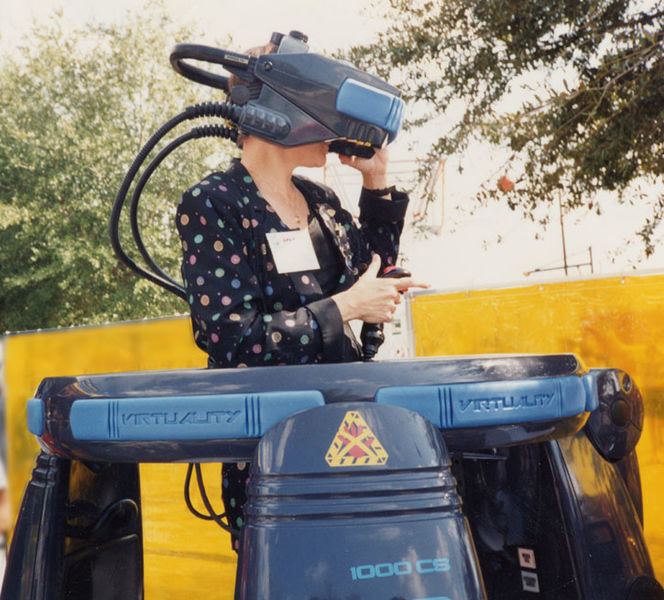
Articles
Editor’s Picks
Education Technology
The Emotional Power of VR in Education Has Arrived
By Henry Kronk
June 15, 2020
For years, education stakeholders have seen huge potential in the use of VR in education. And for years, it has remained just that: potential, promise, a (virtual) reality that waits around the corner. Devices remain expensive. Experiences are limited and solitary. And in many cases, learners get more excited about the virtual reality itself than the content it delivers. The people at HTC Vive believe that is changing. The company has been developing both internal and external capacity. On May 21, they announced they had made a €3 million investment in Irish startup Immersive VR Education. In addition, they have worked to release numerous education titles over the past months.
“At HTC, we’ve focused our efforts on making VR a viable tool in the classroom by investing in content that engages students across a range of subjects,” said David Sapienza, AVP of Content and Production at HTC Vive. “We’ve partnered with forward-thinking startups as well as some of the world’s most iconic institutions to further develop and support new pedagogical tools and experiences. We are looking at ways to bundle hardware and VR content together for educators to make VR more accessible for the classroom and hope to follow up with you in the future.”

HTC sent me a Cosmos system so I could see for myself. The first experience I downloaded was War Remains, a collaboration between history podcaster Dan Carlin, Flight School Studio, and MWM Interactive involving World War I.
VR in Education Can Pack a Visceral Punch
You begin the experience in a biplane. On all sides, you see other aircraft flying, moving in and out of storm clouds. Suddenly, enemy planes come into view firing machine guns with flashing tracer bullets. You watch as, to your right and left, the other craft in your party are hit and burst into flame. Clouds obscure your vision again. The voice of Dan Carlin speaks in your ear: “Some day we’re going to be able to preserve memories and then walk a mile in the moccasins of the people from the past.”
Over the next 15 minutes, you are given a crash course in trench warfare. You sit in a kerosene lamp-lit shelter while enemy shells crash in your ears, you hunker in the mud while tanks roll over head in preparation for a counter attack, and then you yourself go over the top.
War Remains keeps you in a state that ranges from anxiety to fear. It gives you constant goosebumps. The fifteen minutes feel like an hour. Just before the credits roll, Carlin says, “Maybe it helps us to better understand our times if we recall that they were built by a generation of traumatized survivors forever reliving an early 20th century nightmare.” Then you take off the headset and sit down as relief floods in.
I am someone who loves history. Besides studying WWI in school, I have read numerous accounts of the event, such as novels like Erich Maria Remarque’s All Quiet on the Western Front and Ernest Hemingway’s A Farewell to Arms, along with first-person accounts like Robert Grave’s Goodbye to All That, and T.E. Lawrence’s Seven Pillars of Wisdom. I’ve been incredibly moved by films like Joyeux Noel, Lawrence of Arabia, Gallipoli, 1917, and They Shall Not Grow Old. I have also listened to all of Carlin’s own podcast treatment of WWI, Blueprint for Armageddon.
Through these, I had thought I had come to understand WWI both intellectually and emotionally. I was wrong.
War Remains delivers a visceral punch that my imagination simply could not conjure. That’s not to say that the experience in any way takes liberties with history or sensationalizes its account. On the contrary, I would argue developers could be even more frank with their depictions of trench warfare without stretching the truth. This is something that has the power to impart an understanding of history that goes miles beyond lectures, textbooks, fiction, and film.
Virtual Reality’s History of Promise and Disappointment
People have been waiting and anticipating an experience like War Remains for decades. Virtual reality is not new technology, nor is its use in education and training. An early version was developed in the late 1970s by NASA’s Jet Propulsion Lab. The technology goes through repeated cycles of excitement and promise (and produces articles very similar to this one) only to meet challenges and fade from collective memory.

W Industries began mass producing their ‘Virtuality’ systems in the early ‘90s and deployed them widely in arcades. The November 1992 issue of Computer Gaming World included an article featuring these systems and predicted “Affordable VR by 1994.”
“The feeling in VR circles,” writes CGW’s Craig Engler, “is that a home system will have to cost less than $500, come with at least one game and have an immersive hardware system with graphics equal to that of current video game consoles. While Virtuality accomplishes most of those technical feats with a price tag of $60,000, comparable units at one hundredth the cost are only a year or two away.”
Despite Engler’s claims, VR in the ‘90s also suffered from the limits of computing power and speed at the time. For years, the limits of VR were its field of view and its ability to create a virtual environment that would follow the user’s gaze fast enough that it wouldn’t appear to lag.
Palmer Luckey, the founder of OculusVR, made waves when he achieved a 90º field with his prototype in 2010. Michael Abrash and the Valve Corporation made important progress with the lag issue in 2013. The company soon partnered with HTC to develop a consumer product.
Abrash took the stage at Steam Dev Days 2014 to say, “Compelling consumer VR device hardware is coming, probably within two years. It’s for real this time.”
Consumer VR As We Know It Is Just a Few Years Old
Developer kit devices became available from both providers, while consumer-facing products stuck to Abrash’s schedule and were first sold in 2016. Even then, neither satisfied Engler’s standards for widespread consumer adoption. The Rift Consumer Version 1 retailed at $599.99, while the Vive came in at $799. To use them furthermore, one also needed a gaming system. Costs have continued to drop today, but they remain expensive.
Despite these costs, VR in education efforts have gained wide use in certain areas. These include specialized training programs for professionals like pilots and emergency responders. Some large companies like KFC, Walmart, and McDonald’s have developed VR training initiatives to onboard employees. But for general education, the costs remain high.
Smartphone VR
At the same time, smartphones have had VR capabilities since Google launched its 360º Daydream initiative for Android and iOS in 2015. Using 360º or panoramic video and a simple—even handmade—headset that allows users to place their smartphone into the viewer, people could get a VR experience without spending hundreds of dollars.
While smartphones can deliver a VR experience, they’re not perfect. 360º video is data-heavy for a mobile device and it quickly drains batteries. Legendary video game developer John Carmack in his role as Oculus CTO offered a “eulogy” for the Samsung Gear VR viewer in October of last year. Shortly after, Google announced it was discontinuing its Daydream View headset and ending Daydream support for the Google Pixel 4. As Carmack commented about Gear VR to The Verge at the time, “if you have to pop your phone out of your phone case and dock it in a headset, you will use it twice.”
Still, smartphone VR had proven popular with some teachers. Vancouver iTech Preparatory social studies teacher John Zingale told eLearning Inside in 2018 how, using VR, he brings his students to other parts of the world. “When I do my unit with my sixth graders in world studies called Adaptation, [a unit on climate change], we do one module where we look at how climate change is affecting certain countries in the developing world. We actually visit the streets of Bangladesh,” Zingale said. “I pull it up on Google Street View, and we have the students stand in the streets. And they can see really clearly that there’s a different level of poverty in those countries than in our country.”
Educational VR as a Driver of Empathy and Engagement
Despite this setback, it does seem that VR in education hasn’t simply returned to a familiar position it held in a recurring cycle (like in 1992), but has reached a new step.
Many educators and researchers see the VR systems developed by HTC Vive and Oculus as the real drivers of educational experiences. Many have already recorded their potential to drive students’ interest in a subject.
A 2019 literature review of VR in education research identified 119 academic reports on the technology and 38 experiments. Many of these applications were important for skill training that couldn’t easily be delivered safely to new students. For example, the simulation “Hot Dogs, Horseshoes, and Hand Grenades,” teaches soldiers to clear buildings of potential threats.
But when it comes to more general education, 10 described VR as a technology that increases learner engagement. As the authors write, “Purposes of engagement allowed a user to feel involved in the learning process, usually by being offered challenges or interactive elements within the educational virtual environment.”
As an example, they cite Jaunt VR’s “The North Face: Nepal VR” experience which brings viewers into the Himalayas.
“One of virtual realities greatest abilities is to teach empathy,” HTC Vive’s Sapienza said. “VR grants us the opportunity to experience different perspectives and immerse us in subjects like no other educational tool can. HTC VIVE has funded a number of experiences through its content and platforms division that do just that. From educational content developed for the home or public institutions to investing in workforce training applications, HTC believes that VR has the potential to broaden our understanding of the world by experiencing new point of views first-hand.”
HTC Vive and Educational VR’s Future Outlook
For educational VR to gain wider acceptance, two things need to happen. Costs need to continue to fall. And developers like Vive Studios, Immersive VR Education, MWM Interactive, Flight School, and many more need to continue to make the case that this technology has a power and use in education that other media cannot achieve.
The needle is moving on both dials.
More and more, hardware developers are releasing standalone VR systems that do not require a gaming system or computer to use. Oculus currently offers the Quest and the Go models, the latter of which retails for $200. HTC Vive has the Focus Plus (which costs significantly more). Lenovo’s and Pico’s standalone VR model is projected to arrive in the third quarter of 2020.
“HTC recognizes the potential for VR in the classroom and strives to make this tool more accessible by supporting and investing in educational software,” Sapienza said. “We believe both educational and business use of VR headsets and applications will drive broader consumer adoption of the technology. So, we’ve invested heavily in both areas.”
In terms of educational VR experiences, many are taking off. Besides War Remains, I also went through Holy City, a virtual look at Jerusalem as a center of Islam, Judaism, and Christianity. It mixes both 360º footage and virtual environments. I also experienced Anno 1500, an investigation into Gammelstad Church Town, a norther Swedish village (and a UNESCO World Heritage Site) in the year 1500. I wrapped things up with Circadian Rhythm, a VR experience of the rhythms that run our bodies.
“Over the long term, for VR to become a mainstay in the classroom, course catalogs and supporting curriculum will need to be created for VR use,” Sapienza said. “We’ve seen a number examples recently of students and teachers meeting in a virtual classroom to stay connected during stay-at-home orders. As VR demand grows higher, we’ll also see curriculum libraries grow to match the demand.”
Featured image courtesy of HTC Vive.









No Comments